The ultra portable/subnotebook market continues to grow


We now know that Dell and Acer (link to jkOnTheRun article are joining HP and Asus in this market so there is definitely something the big boys see in this category. CNET UK has a first look at a new device from a smaller player, the MSI Wind. They also just posted a video of it in action to whet your appetite even further. The MSI Wind looks a lot like the Asus EeePC, but is a bit bigger and contains a processor that cannot yet be disclosed. It has a 10 inch 1024x600 resolution display, 1GB of RAM, 80GB hard drive, integrated WiFi and Bluetooth radios, three USB ports, 4-in-1 memory card reader and a battery that provides a reported 3-4 hours.
I think this kind of adoption in the ultra portable/subnotebook market is what Microsoft was hoping for with the Origami/UMPC devices, but I think there were a couple of things that held it back from really taking off. One has to be the price because UMPCs came in at over US$1,000 compared to the EeePC coming in at less than US$400. There have also been subnotebooks around for a few years, but many from Sony, Toshiba, and others cost over US$2,000. James pointed out what I think another major reason was and that is the form factor familiarization. People are not familiar with a slate UMPC/Tablet PC or a super small device with different configurations, but they can look at the EeePC and see a mini notebook that looks just like a bigger notebook with a smaller keyboard and smaller display.
Do you agree that price and form factor may be what kept the UMPC market from taking off, but is what is helping with the excitement around these mini notebooks?